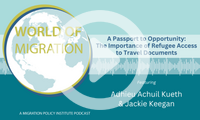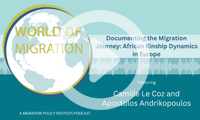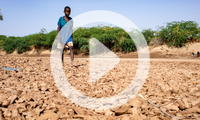International Program
Recent Activity

This webinar examines the challenges that refugees and other migrants face in—and place on—secondary cities, municipal capacity to respond to needs, the types of support required at national and other levels, and how development actors can better partner with secondary cities and local actors.

Travel documents play an important role in international mobility, and for refugees serve as an essential gateway to a world of opportunities, from pursuing education and employment to reuniting with family. This episode unpacks the complexities around travel documents and their pivotal role in refugees' livelihoods.

With the Global Refugee Forum approaching, this webcast explores how municipalities and other key stakeholders can be engaged in informing and delivering on the 2024 resettlement and complementary pathways pledges.

African migrants turn to the strength of kinship-based support systems in pursuit of stability as they settle in a European landscape that is sometimes made precarious by their legal status and shifting policies. This episode discusses use of the kinship networks, including to exchange or broker identity documents between migrants along the migration journey and at destination.

During this MPI webinar, climate experts and regional authorities outline the challenges related to climate change and human mobility that local communities, national governments, and the IGAD region are confronting.
Pages
Recent Activity
Some of the strictest COVID-19 pandemic-era limits on human mobility occurred in the Asia Pacific region. Border closures started in East and Southeast Asia in early 2020 and quickly spread through the entire region, in some cases remaining in place for more than two years. This report examines the approaches countries took and reflects on the immense costs and benefits of using border measures to tackle public-health risks.
The COVID-19 pandemic’s impacts on mobility in the Middle East and North Africa were immediate and wide-reaching. These include the world’s largest and most sustained repatriation efforts for stranded migrants, halted and reversed irregular journeys, and a reckoning with some countries’ reliance on foreign labor. This report examines how these impacts varied across countries in this highly diverse region, as well as the uneven recovery.
The COVID-19 pandemic hit South American nations at a time when many were already contending with major migration challenges. Historic levels of intraregional migration and displacement, notably from Venezuela, collided with countries’ attempts to stop the spread of a new threat to public health. This report examines the region’s responses to the public-health crisis, and the immediate and lasting impacts on cross-border movement.




























As Europe and the United States Face Similar Migration Challenges, Spain Can Act as a Bridge
Spain and the United States both receive their greatest number of immigrants from Latin America, and have worked collaboratively together on displacement crises and other migration issues. As shared immigration challenges dominate debate on both sides of the Atlantic, Spain can serve as a vital bridge in the policy conversation, this commentary notes.
Continue reading